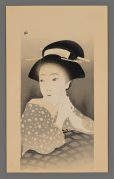Saburosuke, Okada, 1869-1939

Born in Saga prefecture. Studied at private painting school of Soyama Yukihiko. Also assimilated the plein-air style of Kuroda Seiki and Kume Keiichiro. Exhibited Western-style painting at National Industrial Exhibition in 1895. Began teaching at Tokyo School of Fine Arts in 1896. Active with Kuroda Seiki and Kume Keiichiro in establishing Hakubakai in 1896. Went to France in 1897; studied painting with Raphael Collin and also engraving. In 1901 returned to Japan and resumed teaching at Tokyo School of Fine Arts. In 1912, with Fujishima Takeji, established the Hongo Painting Institute. Credited with introducing color etching to Japan. Principally known as metal-plate artist but had close associations with moku-hanga artists and contributed moku-hanga to Kofu, the magazine of Hakubakai, and Complete Collection of Chikamatsu, 1923. Founding member of Yofu Hangakai, an association of etchers and lithographers, in 1930. Returned to France in 1930; discussed with Hasegawa Kiyoshi the possibility of an exhibition of modern Japanese prints in Paris. To facilitate such an exhibition urged members of Yofu Hangakai and Nihon Sosaku-Hanga Kyokai, as well as independent artists, to unite to form Nihon Hanga Kyokai in 1931; became president. In 1937 became member of Imperial Art Academy and was awarded Order of Cultural Merit.** Taken in whole, or in part, with permission from: Merritt, Helen and Nanako Yamada. Guide to Modern Japanese Woodblock Prints: 1900-1975. University of Hawaii Press: Honolulu. 1992.
